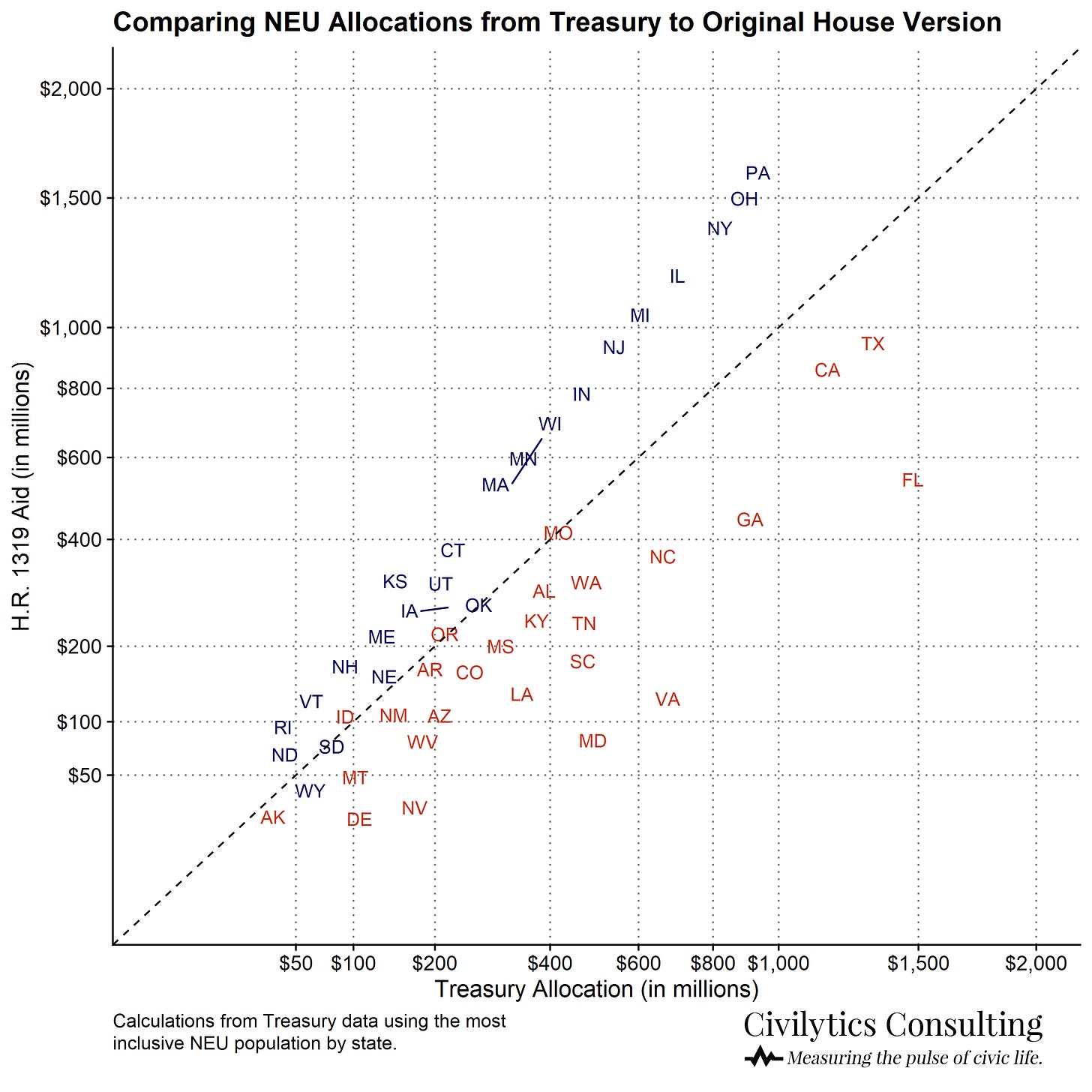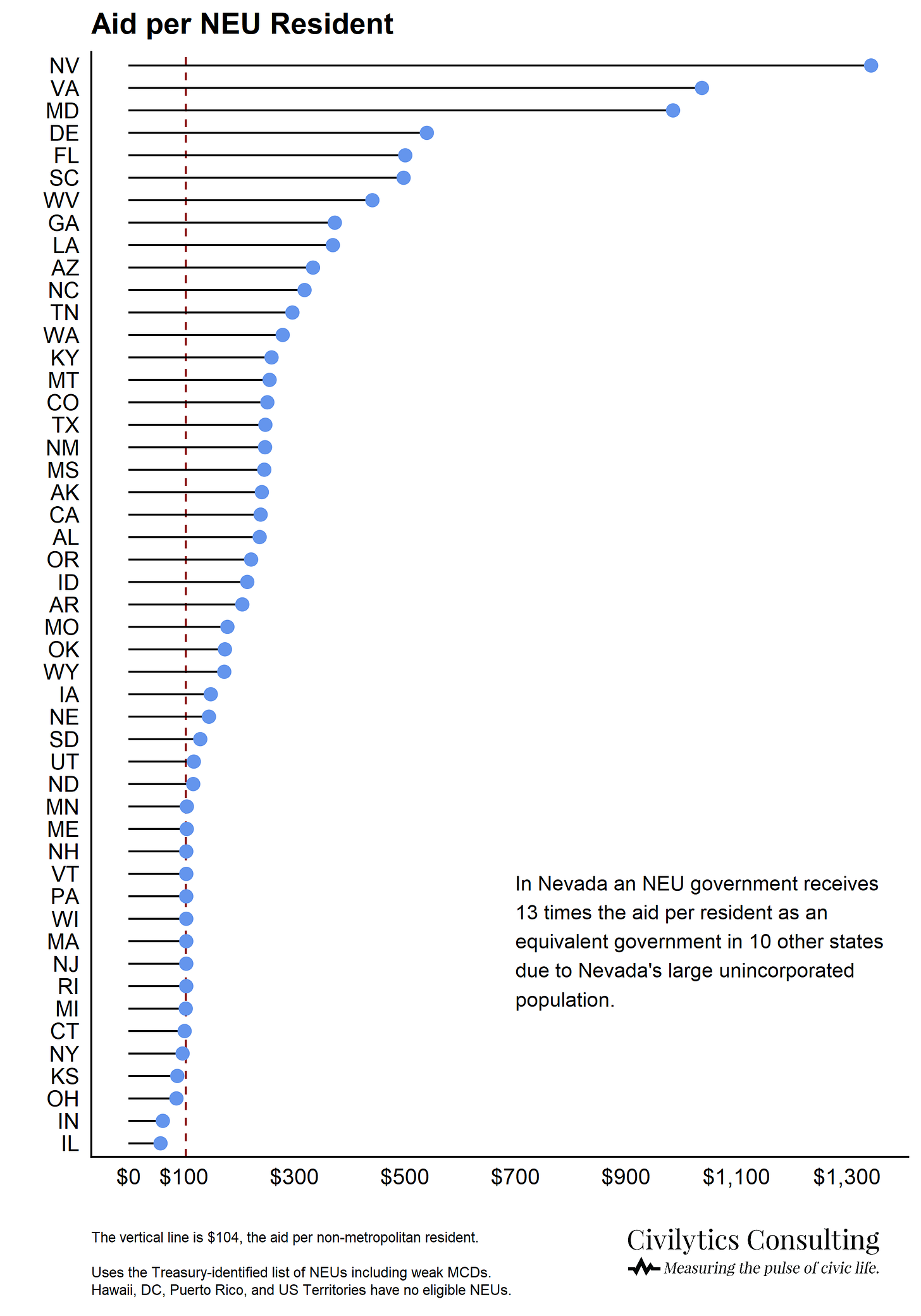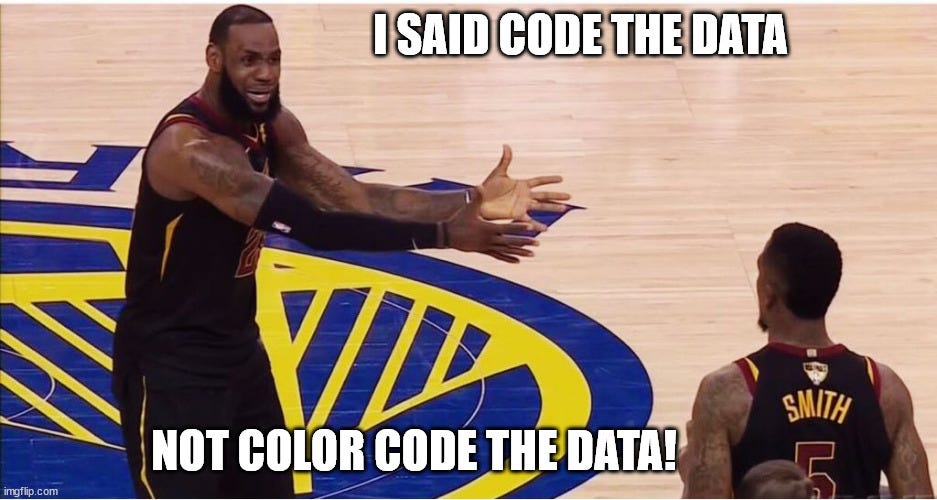Analysis featured in major story
We’re thrilled to share this Intercept article by Rachel Cohen featuring our analysis uncovering a $5 billion change to how ARPA aid is distributed.
From the article:
According to Civilytics researchers Jared Knowles and Hannah Miller, in states that have large populations living in unincorporated areas — places outside the bounds of local or municipal jurisdiction, governed only at the county, state, and federal levels — local governments will now receive much higher per capita funding than those in states without them.
We’re going to dedicate this edition of The Civic Pulse to telling you how this story came together, why it matters, and what you can do about the disparity the analysis uncovered. Aid to over 27,000 small cities and towns and over 100 million people is affected by this change.
In this newsletter you’ll learn:
- What’s the big deal with ARPA aid to small towns?
- How did Civilytics find this out?
- Digging into the data: What makes it so hard to get right?
- Why did Civilytics uncover this when no one else did?
- What can be done now?
If you read no further, let us just say that this story was a (free) labor of love. Civilytics’ mission is ensuring that, in a world where policy increasingly relies on data, data work is done carefully and accurately and in ways that democratize information rather than reinforcing the power of gatekeepers and insiders. We saw a hole in the data work around this incredibly huge aid program—and the more we dug into it, the more we realized that no one else (at least publicly) was recognizing the impact of this 5-word change.
We think this is a great example of how we’re trying to do public data analysis differently at Civilytics and we need your help raising awareness about why that difference matters. So, to help us out, if you found this story interesting, please share our newsletter, the article in the Intercept, or our press release with your networks.
For more details on the story and a behind-the-scenes look at how we put our best data skills to work (no, not multilevel modeling; just matching Excel files by hand), read on:
OK, so what’s the big deal with ARPA aid to small towns?
So what’s the article say? Here’s the tl;dr:
First identified by the data consulting firm Civilytics, the change in terminology established a new aid formula that shifted $5 billion, or 25 percent of the total program, creating sharp disparities depending on how states classify their communities.
You can read more details of our analysis and its implications on our website (Part 1, Part 2, and Part 3). The point is that a seemingly small 5-word change in a Senate amendment made it easier to calculate how money would be allocated to states on behalf of their NEUs but perhaps unintentionally resulted in a distortion in the per-resident aid NEUs receive across states. This distortion is large: NEUs in some states will receive 10x as much per resident as those in others. For some communities, this means missing out on millions of dollars.
It’s great for [Maryland small towns], they’re going to get a lot of money,” said Marc Nicole, deputy secretary at the Maryland Department of Budget and Management. “I’m going to say some of them are going to do a great job [with the funding] and will have really good ideas, and for some of them, it’s going to overwhelm them. We have one municipality that has a population of 15. They’re going to get like $14,000.
If that seems like a big deal, it is! This aid program affects thousands of towns and cities, tens of millions of people, and billions of dollars. The details really matter.
Senate sources said the change came at the behest of officials at the Treasury Department and the Department of Housing and Urban Development. The thinking, they said, was that the shift to “non-metro” populations could provide a more expedient way to distribute funds than using NEUs…. But that doesn’t explain why the Treasury Department then published guidance restricting which NEUs could receive funds, taking flexibility away from states that could otherwise have directed some money to unincorporated areas.
The article explains that there may still be time do something about this. Keep reading for ideas on how this might occur.
We also want to reiterate that getting our work into a national publication takes a lot of effort – we don’t have the name recognition or extensive network that makes that easy. Instead, we had to pitch and pitch and pitch again, and make sure we had every detail of the analysis right and could explain the implications clearly. In the end, that was a big investment of our time, and we are thrilled that a talented investigative journalist, Rachel Cohen, was able to use our work to ask the right questions of the people in the position to do something about this. While you’re here, consider subscribing to her newsletter as well.
How did Civilytics find this out?
For our newsletter, we want to share how the story unfolded from our seat because we think it illustrates what Civilytics is all about.
As the American Rescue Plan Act (ARPA) neared passage, Civilytics began helping community organizers understand how much money their community would receive so that they could begin building momentum and pressure to publicly discuss how to use funds. When timely aid estimates weren’t available, Civilytics produced our own, first publishing tools to look up your community’s projected allocation in March. Then we updated those tools with each new, but incomplete, release of information from Treasury.
At the end of May, a community health organizer contacted us about a difference between our estimates and new information available from the Treasury about aid to smaller cities, towns, and villages – called “non-entitlement units” or NEUs by the law. When updating our estimates, we discovered that, while Civilytics had assumed an equal distribution of aid based on the text of the House bill, a Senate amendment led NEUs in some states to be eligible for 10 times as much aid per resident as those in other states.
And then we started digging…
Digging into the data: What makes it so hard to get right?
This inspired us to dig into the extent of the disparity and how it resulted from using two non-equivalent population definitions (first post on the topic). We learned that Treasury was allocating aid to states based on their “non-metro population” but instructing them to pass-through the aid based on “non-entitlement populations.” In some states, the two populations are synonymous (or nearly so), but, in other states, it’s a difference of 5 million people or more. The result is that, for example, an NEU of around 50,000 people in California will get $12 million in aid, or $239 per resident, while one in Connecticut will get less than half as much, about $5.6 million in aid, or $101 per resident.
Count, then count again.
This was a head scratcher – at first, we didn’t believe it. So next we tried to understand why the law didn’t use the same population in both places. We learned that the House version of the bill did, allocating aid states based on their NEU population and instructing states to pass-through the aid based on the same populations. However, a Senate amendment changed that (second post). We couldn’t find any public discussion of why this change occurred, but we did look into how much it mattered.

We found that NEUs in at least 13 states are now getting 40% less aid than they would have under the House version. For example, PA lost around $689M from this change and OH, NY, and IL all lost around $500M or more. In contrast, Nevada, Maryland, and Virginia are getting more than 4 times as much aid (up to $1k or more per NEU resident) thanks to the change.
Then we wouldn’t be Civilytics if we didn’t also write a third postabout our methodology. The data folks in our audience may particularly enjoy this post about our efforts to merge files with no unique identifiers and use Excel workbooks that had rows organized by color (horror!). Those of you who write administrative data rules may enjoy the opportunity to shake your head about how some aspects of this were rolled out: allocations but not populations published for metro cities, populations but not allocations published for NEUs, etc.
Why did Civilytics uncover this when no one else did?
We’d like to think it’s because we’re so sharp but more likely it’s because:
- We’re very excited about ARPA’s promise to help address longstanding systemic inequalities. We want to see the program implemented in a way that meets its laudable goals. We are working with groups that aren’t political insiders and didn’t have – but really needed – information about their city’s allocation.
- We tried to replicate Treasury’s numbers to understand them. Being able to understand where the numbers are coming from and how they’re produced – not just viewing a PDF of what they are – is a critical part of transparent, democratic data analysis and communication.
- We know that this is hard and complicated work. We’ve seen that rolling out intergovernmental aid requires careful data and communication work (hat tip to Brian Pahnke and John Johnson at the Wisconsin Department of Public Instruction for teaching us this). We understand that federal data on local governments has limitations (no census of populations served by local govts in the U.S.!) and were curious to see how Treasury resolved these limitations. And we know that data sources and business rules really matter for government agencies (Jared wrote a book on this!)
- Also, and this is no small part of it we’re sure, we were willing (mostly) to sink 2+ weeks of “public service” (aka donated time) into understanding the story inside and out.
And maybe other organizations overlooked this because:
- NEUs are small and dispersed (27,000+ of them), so they get less attention from media orgs, data analysts, funders, and advocates.
- Replicating aid allocations is not as much fun as making proclamations about how to use the funding (which we’ve also done and are going to do again soon).
- Or maybe others did and chose not to make it public – knowledge is power, after all.
What can be done now?
For your community:
Treasury is seeking comments on these regulations until July 16 – submit yours here. (You can read a draft of our comments here.) If your state is receiving less aid per resident due to this Senate amendment, we encourage you to contact your senator to learn more about why this change was made without any public discussion. We honestly don’t think many (or any?) senators understood the impact of this change.
Most of all, regardless of where you live, please – if you can – get involved in deciding how these once-in-a-lifetime funds are used in your community. (Our next post with more ideas on how to spend ARPA funds reflects some of the funding choices we’re trying to encourage our community to make.)
To help us out:
If you’ve made it this far, thanks! We are so grateful for our newsletter readers!
We believe our public institutions’ data teams need to walk (that is, count right and publish auditable and authoritative data) before they run (i.e., build complex statistical model pipelines). And need to publish their data accessibly and communicate it well to avoid data being used to insulate gatekeepers and privilege incumbents. We love statistical models too but counts matter. Even more importantly who gets the information when matters. We hope this serves as a case study for how and why government needs to do better – for all of us.
If you agree, sharing stories like this really helps. Only if these stories get attention can they become case studies for how we can do better in the future.
So again, please take the time to share this newsletter and the story with your networks.
Our next newsletter will be back to our regularly scheduled set of topics, reporting on some of the other work we’re doing and links we’re excited to share. See you in a few weeks!




